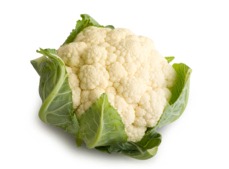Cauliflower

Cauliflower (Brassica oleracea botrytis) is an old favourite in Britain, but its popularity has been in decline in recent years.
In the UK maincrop varieties of summer cauliflower are sown outdoors in spring for harvesting in summer and autumn. It is grown much like cabbage, but requires more careful treatment and is susceptible to boron deficiency which browns the curd and manganese which restricts lateral leaf growth. The main crop is spring-planted cauliflower, which is said to be more flavourful than other varieties and prefers to mature in cooler weather. Like other brassicas it suffers from a wide variety of parasites from slugs, snails and insect larvae to various fungal and bacterial species.
To deter some of its enemies, traditional gardeners grow cauliflower along with mint. Another eco-friendly answer is to introduce the stingless trichogramma wasp, which parasitises the eggs of insect pests.
The Dressing Process
Field Science tailored mineral dressings are always based on detailed soil analysis of the field to be treated. A member of our technical team will visit your farm to discuss and identify where we can help. Soil samples are then taken and the tailored dressings are based on the independent laboratory’s results.
The Single Crop Dressing is the best option for cauliflowers as the soil is usually ploughed after harvest and that would effectively bury a multi-year dressing out of reach of the roots.
The best time for application is just after emergence or planting-out of module-grown plants. The application rate is usually 25kg per hectare (10kg/ac) and the most effective method of application is to use an electric spinner (slug-pelleter) on a quad bike. The dressings are packed in 25kg bags, clearly labelled with the farm details, field name, application rate and bag weight.
